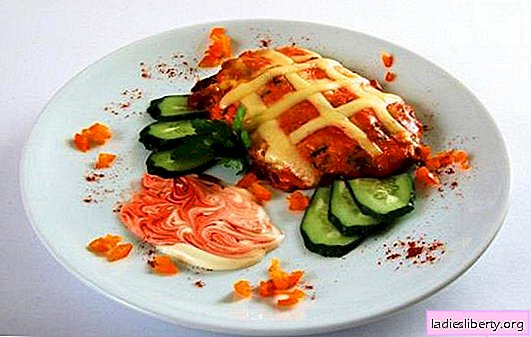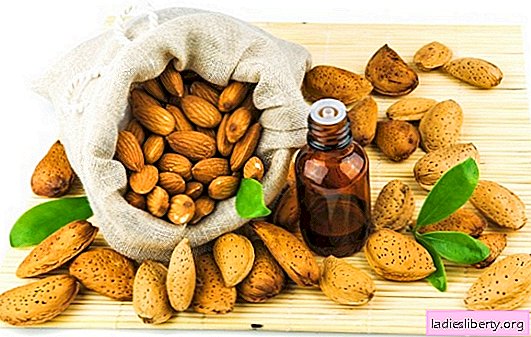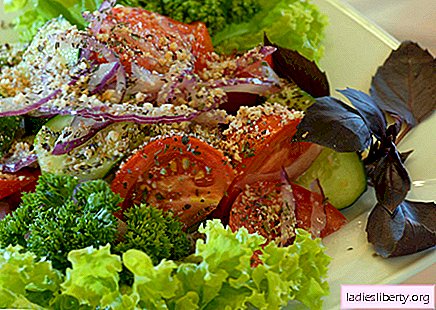
Diabetes - a systemic violation of the processing of macro-energy substances with the subsequent development of metabolic instability.
Diabetes affects people of any age and gender, and is also characterized by the severity of symptoms and many complications, therefore it is a life-threatening danger.
In addition to specific treatment, it is important to choose the optimal nutrition system for the patient.
General principles of nutrition with high blood sugar
To begin with, it should be noted that the rise in blood sugar does not always indicate the presence of diabetes. The pancreas can reduce activity during prolonged stress, depression, etc. In this case, elevated blood sugar may be a normal variant. Only an endocrinologist can make a diagnosis based on the results of the diagnosis.
Diabetes - a terrible disease. Therefore, in no case can not be neglected diet. Almost everyone knows that diabetes is of two types: 1st and 2nd, but only a few can name the difference between them.
The difference is quite clear: type 1 diabetes associated with disruption of the pancreas for organic reasons (comorbidities such as pancreatitis, genetic disorders, etc.). Type 2 diabetes almost always associated with obesity and is its consequence. The pancreas simply does not withstand the load and fails.
Therefore, you need to approach nutrition especially carefully, taking into account your form of the disease.
Foods Allowed for High Blood Sugar
With type 1 diabetes
1) Bread from whole grains, rye bread.
2) Wheat bran.
3) Soups cooked in vegetable broths, as well as soups in weak meat broths (chicken, veal, lean beef).
4) Legumes: beans, lentils.
5) Dishes from lean meats: beef, chicken, rabbit, turkey. The main rule: eat meat without skin, as many love it. It is better to give preference to boiling, stewing or baking, as a method of cooking.
6) Low-fat varieties of fish: cod, pike, pike perch, etc. In any case, fish oil has a slightly different structure, non-living animal fat. Therefore, you can consume fish without removing the skins.
7) Fresh and cooked fruits and vegetables. There are no particular limitations here. You can: watermelons, apples, citrus fruits, pears, cherries, pomegranates, plums, etc. Vegetables can be consumed without fear, with the exception, perhaps, of potatoes. Excess starch in potatoes imposes certain restrictions. As you know, in the body, starch is hydrolyzed to glucose, which means there will again be elevated blood sugar. Potatoes are best used in the form of mashed potatoes. When boiling, a portion of the starch "goes" into the water and the concentration of the substance in the tubers falls.
8) Porridge from cereals: oatmeal, buckwheat porridge.
9) Dairy products. Exceptionally low fat or fat free. Milk, unsweetened yogurt, kefir, low-fat cheeses.
10) chicken egg. It is permissible to consume up to 7 eggs per week.
11) Vegetable oils. Creamy can also be consumed, but at 25-30 grams per day.
12) Drinks: tea, coffee, compotes, fruit drinks.
13) Confectionery: in small quantities.
With type 2 diabetes
The diet of type 2 diabetics is somewhat milder.
1) You can not only whole grain bread, but also in small quantities and ordinary. Including, allowed the use of pasta (within reasonable limits, of course).
2) It is also allowed to use a small amount of more fatty meat.
The rest - the same diet.
Products prohibited with high blood sugar
In this case, there is no difference between the types of diabetes.
1) Bakery products: cookies, cakes, pies, butter products.
2) Fried dishes, too salty dishes.
3) Fatty meats: goose, pork.
4) Soups on strong broths.
5) Semolina.
6) Alcohol, sweet soda and other sweet drinks.
7) Canned food.
In limited quantities It is permissible to use:
1) Potatoes (up to 1 tuber per day in the form of mashed potatoes).
2) Honey, sweet fruit (the amount is set individually).
3) Pasta.
4) Sausages (up to 50 g per day).
Principles of nutrition and dieting with high blood sugar
• Power should be fractional. A portion should not exceed 150-300 grams in volume. The frequency of the meal should be 4-6 times. Meal time should be calculated on the basis of standard human biorhythms, adjusted for individual characteristics: the first is 8.00-9.00, the second is 11.30, the third is 13.30, the fourth is 15.30-16.00, the fifth is 18.00, and the sixth is 20.00.
• Biochemical composition of the diet should be as follows: 23-24% fat, 20 proteins, and the rest should fall on carbohydrates.
For persons with type 2 diabetes, the main treatment is weight loss. The main recommendation for such patients is reduce caloric intake by 1/3 - ½ (from the usual amount of food consumed). Sharply refuse food can not.
Substitute products prohibited with high blood sugar
The safety of diabetic products is a moot point. A number of specialists adhere to the traditional opinion that sugar and foods that are prohibited in diabetes should be completely abandoned and they should be replaced with them. Others - directly indicate the harmfulness and danger of their consumption.
Really, fructose cannot replace glucose, especially not capable of sorbitol. Lack of sugar will lead to serious consequences. On the other hand, diabetic products, according to research by foreign scientists, not only really do not contribute, but also aggravate the course of the disease.
Therefore, it is necessary to minimize or completely refuse substitute products.
Diabetic can eat sweets and honey. But only in minimal quantities (for example, 1/3 of sweets per day, 1 teaspoon of honey per day). Surplus, of course, will not lead to anything good.
Now on the market there are a lot of "harmless" substitute products:
1) Candy on sorbitol and fructose.
2) Syrups and juices.
3) Pasta.
4) Sausages.
In most cases, all that has been said about them is a complete fraud and profanation, or a lack of qualifications of a doctor.
The only ones who benefit from the consumption of such "food" are manufacturing companies.
The diabetic diet should consist only of natural products.
Diet with high blood sugar: a rough menu for the week
Focused on 5 meals. If necessary, this menu can be divided into 6 times a day.
Monday
H.
1. Rye bread, one piece (30 grams)
2. Buckwheat porridge, friable (28-30 g).
3. A soft-boiled egg.
4. Salad of assorted vegetables (cucumbers, tomatoes, cabbage).
5. A glass of weak tea.
6. Green apple.
V.Z.
1. Dry biscuits (cracker, 20 g).
2. A glass of juice (tomato).
3. Half a banana.
ABOUT.
1. A piece of rye bread.
2. Beetroot (300 ml).
3. Steamed chicken cutlet (40 g).
4. Crumbly buckwheat porridge (30 g).
P.
1. A piece of rye bread (23-28 g)
2. A piece of sausage (55 g)
3. Salad of assorted vegetables (55 g)
4. A glass of juice (tomato).
W.
1. Bread.
2. Mashed potatoes (60 g).
3. Boiled fish (steam cutlets can be) (110 g).
4. 1 green apple or half a banana.
Tuesday
H.
1. A piece of rye bread (30 g).
2. Oatmeal porridge (55 g).
3. Salad of assorted fruits (50 g).
4. A piece of lean meat (40 g).
5. A glass of tea with a piece of lemon.
6. Crackers (35 g).
V.Z.
1. Apple or banana (150 g).
ABOUT.
1. Bread.
2. Meat soup with vegetables (230 ml).
3. A piece of lean meat (veal) (35 g).
4. Mashed potatoes (60 g).
5. A glass of berry broth.
P.
1. Fruit (orange).
2. A glass of unsweetened yogurt.
W.
1. Bread.
2. Buckwheat porridge, crumbly (60 g).
3. A glass of juice (tomato).
4. Salad of assorted vegetables (60 g).
Wednesday
H.
1. Bread.
2. A piece of boiled fish with a vegetable side dish (105 g).
3. Salad of assorted vegetables (40 g).
4. Half a banana.
5. Fruit broth.
V.Z.
1. Pancakes with low-fat cottage cheese (60 g).
2. A glass of tea.
ABOUT.
1. Bread.
2. Vegetable soup (130 ml).
3. Chicken liver (30 g).
4. Berry decoction (glass).
P.
1. Fruit to choose from (apple, banana, peach).
2. A glass of kefir.
W.
1. Bread (half a piece).
2. Buckwheat porridge (60 g).
3. Steamed fish cutlet.
4. Crackers (30 g).
5. A glass of tea.
Thursday
H.
1. Dumplings (7-8 pieces).
2. Salad of assorted vegetables (30 g).
3. Crackers (40 g).
4. A glass of berry broth.
V.Z.
1.4 apricots.
2. A glass of kefir.
ABOUT.
1. Bread.
2. Soup with buckwheat (150 ml).
3. A piece of boiled chicken meat (60 g).
4. A glass of tea.
P.
1. Green apple.
2. Cherry or sweet cherry (80 g).
W.
1. Bread.
2. Porridge (60 g).
3. Steamed fish cutlet.
4. Salad of assorted vegetables (30 g).
5. A glass of broth hips.
Friday
Repeat menu on Tuesday.
Saturday
Repeat menu on Wednesday.
Sunday
H.
1. Potato pancakes (2-3 pieces).
2. Vegetable salad (40 g).
3. Tea without sugar.
4. Half grapefruit.
V.Z.
1. Vegetable dumplings.
2. A glass of kefir.
ABOUT.
1. Bread.
2. Beetroot soup or borsch (110 ml).
3. Steamed chicken cutlets (1-2 pieces).
4. A glass of berry broth.
P.
1. Fruit to choose from.
2. A glass of red currant or lingonberry.
W.
1. Bread.
2. Buckwheat porridge, crumbly (60 g).
3. Steamed meat cutlets (veal) (1 pc.).
4. Cabbage quenching (60 g).
5. A glass of coffee or tea.
Thus, ideas about the diet of a diabetic are currently very outdated in Russia.
Diabetes is not just possible, but it is necessary to consume all those products that a healthy person eats, including sugar, flour products, etc. This will protect against sudden surges in glucose levels and set it at a stable level.
In each case, the diet menu is selected individually. The most important principle is not to overload the pancreas. Therefore, food should be fractional and relatively light.











